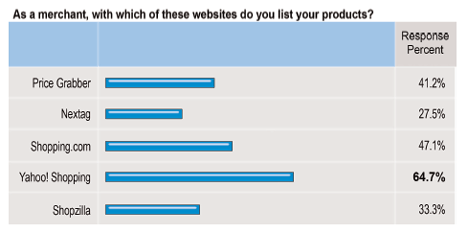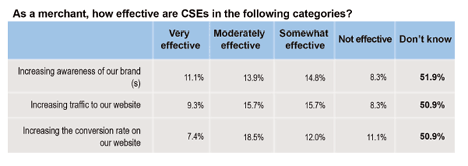Comparison Shopping Engines

Should CSE's Be Part of YOUR PPC Mix?
by Nick Loeser
Simply put, comparison shopping engines (CSEs) are search engines for products. And in recent years, they have sprung up on the Internet like wildflowers; mostly because they offer a form of pay-per-click (PPC) advertising that traditional sites, like Yahoo! Search Marketing and Google AdWords cannot.
To begin, a merchant uploads their products to the CSE, either individually or through a custom product feed. Then, when a user searches for a product, those that match - from both the merchant and competing companies - appear on a results page. And, like large search engines, the order in which results appear varies depending on the particular CSE. Some sites like Yahoo! Shopping rank based on bid. Others rank based on relevancy and popularity. Each shopping comparison site has its own algorithm and method for ranking, however, the business model is mostly the same. The merchant pays when a user clicks on their product and is taken to the website.
The obvious advantage to CSE advertising over traditional PPC is traffic is usually better qualified. The person clicking on a listing is likely further along in the buying process and that much closer to making a purchase. Furthermore, listings feature a product picture and typically a short description (before the user clicks) which helps to further filter out browsers and funnel in buyers. Another but similar advantage is that merchants don't have to compete for attention in the crowded marketplace of major search engines. Less competition means that your products have a better chance of being seen by qualified consumers.
The benefit of CSEs for consumers includes researching products, user reviews, locating stores with the best customer ratings and, most importantly, finding the best price.
To find out which CSEs are being used and what kind of results are being seen by merchants and consumers, we sent out an extensive survey to Website Magazine readers of which 331 responded - your peers, and likely some of your competitors.
You can see that Yahoo! Shopping was the clear preference of merchants to list their products. Not coincidentally, it is also one of the most trafficked. And though traffic is an important factor for success with CSEs, there is value in using less popular sites. The PPC model often creates an auction style bidding system for ranking. So if I sell rocking chairs on Yahoo! Shopping, my products are going to be competing with dozens of other merchants selling the same thing. I must increase my bid to have my listing appear towards the top to get more clicks. However, if I use a less popular site I may receive fewer clicks, but I'll likely pay less for each click and arguably less per conversion. It's important to consider this factor when picking a CSE. In the end, the less popular site might result in a higher ROI.
Are CSEs Working for You?
Though consumers are certainly interested in using CSEs, the numbers are not quite as high when you look at merchant's use of them. About 25 percent of survey respondents are currently using the sites as part of their online marketing strategy. However, of that, just 10 percent are currently using 2-4 CSEs, and a mere 5 percent are using 5 or more. You wouldn't want your website only listed in one search engine, so it's hard to understand the lack of exposure across multiple CSEs.
Finally, we asked if merchants are finding success when listing with CSEs. What we discovered was shocking. Just under half of all respondents found the sites to be somewhat effective in both driving traffic and converting sales. But in all categories, the winner was "Don't know" - at least half of all respondents have no idea if their CSE investments are paying off.
When using CSEs you must have a method for measuring your ROI. They all come with some reporting features, but the best way to track your investment is to have your own third-party analytics solution in place. And in this day and age, with the abundance of analytics tools available, there's simply no excuse for not tracking your marketing spend.
_________________
To Use a CSE Or Not To Use A CSE
The big question for merchants when choosing a CSE instead of, or combined with traditional PPC advertising is if consumers are actually using the sites. Our survey found that 53 percent of consumers used a CSE at least once a month - 24 percent of which used them at least once a week. A separate survey question found that 25 percent of respondents find CSEs "very effective" when shopping online, while another 30 percent responded with "moderately effective." Just five percent replied "not effective."
_________________
Using Google Analytics you can easily track your PPC advertising by creating goals. For example, if I am using Yahoo! Shopping, I can segment all traffic referrals from shopping.yahoo.com, and then review the goals (or sales) I received from just that traffic. This is a terrific tool, and free for anyone to use.
Another way of accurately measuring your success with CSEs is to create unique URLs for the product feed. Many popular shopping carts like Miva and Volusion allow you to create affiliates. Each affiliate gets a unique URL as a way of tracking their sales. Set up an affiliate for each of the CSEs you use, and then adjust the product data feed to reflect the unique URL. This will accurately track the origin of your sales.
It's clear that consumers are using CSEs when they shop online. And that means that there is a big opportunity for merchants to garner highly qualified traffic that has a good chance to convert and ultimately increase revenue. Unfortunately, it's just as clear that merchants are not tracking their successes or failures with CSEs. As the busy online shopping season approaches, it's a good idea to explore some of these unique websites and see if your PPC campaign can get a little boost. Of course, you'll never know unless you use your analytics.
5 Popular Comparison Shopping Engines/Services
Yahoo! Shopping (shopping.yahoo.com)
Listing Features: Product picture and description, coupons or promotions, save for later, and merchant ratings.
Shopping.com (shopping.com)
Listing Features: Add as featured (top page listing), product picture and description, merchant rating, merchant logo, and shipping cost display.
Nextag (nextag.com)
Listing Features: Product picture and description, coupons or promotions, save for later, merchant ratings and shipping calculation.
Price Grabber (pricegrabber.com):
Listing Features: Product picture and description, shipping calculation, product reviews, merchant ratings, and merchant logo.
Shopzilla (shopzilla.com):
Listing Features: Product picture and short description, merchant logo, and merchant ratings.
About the Author: Nick Loeser is President of TheSmallMerchant.com, a Search Marketing company and blog. He has been consulting on ecommerce for over five years. He can be reached at nick@thesmallmerchant.com.








